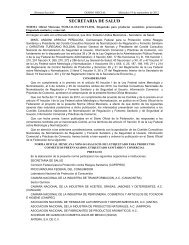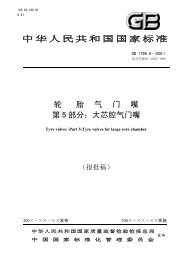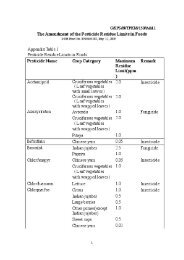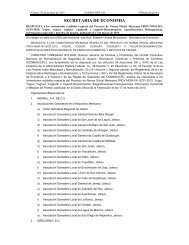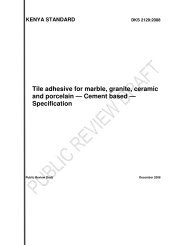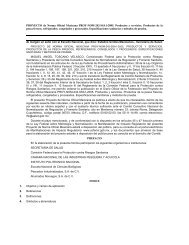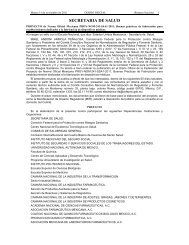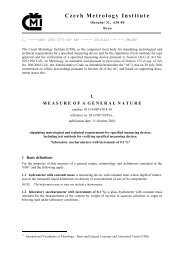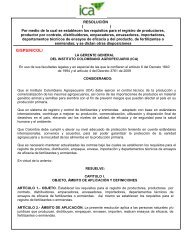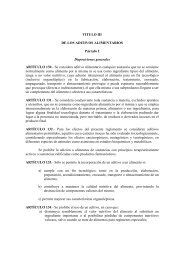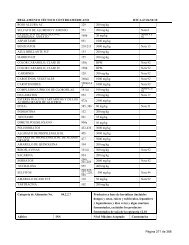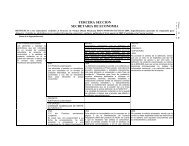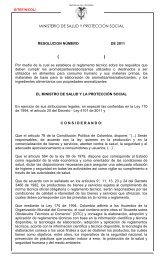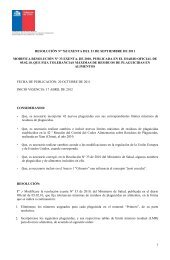Wheat flour — Specification
Wheat flour — Specification
Wheat flour — Specification
Create successful ePaper yourself
Turn your PDF publications into a flip-book with our unique Google optimized e-Paper software.
DRAFT KENYA STANDARD DKS 169: 2009<br />
ICS ICS 67.060<br />
<strong>Wheat</strong> <strong>flour</strong> <strong>—</strong> <strong>Specification</strong><br />
©KEBS 2009 Fourth Edition 2009
DKS 169: 2009<br />
ii<br />
TECHNICAL COMMITTEE REPRESENTATION<br />
The following organizations were represented on the Technical Committee:<br />
National Cereals and Produce Board<br />
Ministry of Health <strong>—</strong> Department of Public Health<br />
<strong>—</strong> Division of Nutrition<br />
Egerton University<br />
Pembe Flour Mills Ltd.<br />
Nestle Foods<br />
Unga Ltd.<br />
Cap[well Industries Ltd<br />
Proctor and Allan (EA) Ltd.<br />
Ministry of Trade and Industry <strong>—</strong> Department of Industry<br />
Government Chemist’s Department<br />
Jambo Biscuits Ltd.<br />
Consumer Information Network (CIN)<br />
Kenyatta National Hospital<br />
Kenya Bureau of Standards ― Secretariat<br />
REVISION OF KENYA STANDARDS<br />
In order to keep abreast of progress in industry, Kenya Standards shall be regularly reviewed. Suggestions for<br />
improvements to published standards addressed to the Managing Director, Kenya Bureau of Standards, are<br />
welcome.<br />
© Kenya Bureau of Standards, 2009<br />
Copyright. Users are reminded that by virtue of Section 25 of the Copyright Act, Cap. 12 of 2001 of the Laws of Kenya, copyright subsists in<br />
all Kenya Standards and except as provided under Section 26 of this Act, no Kenya Standard produced by Kenya Bureau of Standards may<br />
be reproduced, stored in a retrieval system in any form or transmitted by any means without prior permission in writing from the Managing<br />
Director.<br />
© KEBS 2009 <strong>—</strong> All rights reserved
DRAFT KENYA STANDARD DKS 169: 2009<br />
ICS 67.060<br />
<strong>Wheat</strong> <strong>flour</strong> <strong>—</strong> <strong>Specification</strong><br />
KENYA BUREAU OF STANDARDS (KEBS)<br />
Head Office: P.O. Box 54974, Nairobi-00200, Tel.: (+254 020) 605490, 602350, Fax: (+254 020) 604031<br />
E-Mail: info@kebs.org, Web:http://www.kebs.org<br />
Coast Region Lake Region Rift Valley Region<br />
P.O. Box 99376, Mombasa-80100 P.O. Box 2949, Kisumu-4010 P.O. Box 2138, Nakuru-20100<br />
Tel.: (+254 041) 229563, 230939/40 Tel.: (+254 057) 23549, 22396 Tel.: (+254 051) 210553, 210555<br />
Fax: (+254 041) 229448 Fax: (+254 057) 21814<br />
© KEBS 2009 <strong>—</strong> All rights reserved iii
DKS 169: 2009<br />
Foreword<br />
This Fourth Edition of KS 169 was prepared by the Technical Committee on Processed Cereals and Pulses and<br />
it is in accordance with the procedures of the Kenya Bureau of Standards.<br />
This standard incorporates the specific compositional requirements for both fortified and non-fortified wheat<br />
<strong>flour</strong>. The standard has prescribed the permissible levels of food additives in wheat <strong>flour</strong>. Microbiological<br />
requirements for wheat <strong>flour</strong> have also been stipulated.<br />
This revision was done mainly to provide a guidelines of formulation of premix to be used in fortification as well<br />
as to align the microbiological limits in line with the best international practices<br />
During the preparation of this standard, reference was made to the following documents:<br />
iv<br />
Methods for microbiological examination of foods by Mossel, D.A.A. and Taminga, S.K. (Third Edition).<br />
Technology of cereals by N.L. Kent (1998 Fourth Edition).<br />
Guidelines on food fortification with micronutrients, 2006, WHO/FAO<br />
Acknowledgement is hereby made for the assistance derived from these sources.<br />
© KEBS 2009 <strong>—</strong> All rights reserved
DRAFT KENYA STANDARD DKS 169: 2009<br />
<strong>Wheat</strong> <strong>flour</strong> <strong>—</strong> <strong>Specification</strong><br />
1 Scope<br />
This Draft Kenya Standard specifies the requirements and methods of test for both fortified and non-fortified<br />
wheat <strong>flour</strong> (other than durum wheat <strong>flour</strong>s) intended for baking and other modes of human consumption.<br />
2 Definitions<br />
For the purposes of this standard, the following definitions shall apply:<br />
2.1<br />
wheat <strong>flour</strong><br />
is the product made from milling clean wheat grains conforming to the requirements of KS 01-136, <strong>Specification</strong><br />
for wheat grades<br />
2.2<br />
Fortified/enriched wheat <strong>flour</strong><br />
product prepared from grain of common wheat, Triticum aestivum L., or club wheat, Triticum<br />
compactum wheat, Triticum aestivum L., or mixture thereof, by grinding or milling processes in which<br />
the endosperm is comminuted to a suitable degree of fineness to which nutrients have been added in<br />
accordance with this standard<br />
2.3<br />
white wheat <strong>flour</strong><br />
is the wheat <strong>flour</strong> obtained by milling wheat grains at low extraction rates that leaves negligible amounts of bran<br />
2.4<br />
bakers <strong>flour</strong><br />
white wheat <strong>flour</strong> obtained by milling high protein wheat intended for bread making<br />
2.5<br />
household or home baking <strong>flour</strong><br />
white wheat <strong>flour</strong> obtained by milling wheat grades or blends of hard and soft wheat intended for domestic use<br />
2.6<br />
biscuit <strong>flour</strong><br />
white wheat <strong>flour</strong> obtained by milling a blend of hard and soft wheat with a high percentage of soft wheat for<br />
biscuit manufacture<br />
2.7<br />
cracker <strong>flour</strong><br />
{white wheat <strong>flour</strong> obtained by milling wheat with no improvers}<br />
2.8<br />
self-raising <strong>flour</strong><br />
white wheat <strong>flour</strong> obtained by milling a blend of soft and hard wheat to which raising agents are added<br />
© KEBS 2009 <strong>—</strong> All rights reserved 1
DKS 169: 2009<br />
2.9<br />
standard <strong>flour</strong><br />
wheat <strong>flour</strong> obtained by milling wheat grains at a higher extraction than home baking <strong>flour</strong><br />
2.10<br />
wholemeal <strong>flour</strong><br />
wheat <strong>flour</strong> obtained by milling the entire wheat grain to fine particle size without any separation<br />
2.11<br />
atta <strong>flour</strong><br />
wheat <strong>flour</strong> to which pollard or other material has been added to increase the coarseness of the <strong>flour</strong><br />
2.11<br />
diluent<br />
a suitable, inert, food-grade carrier for micronutrients<br />
2.12<br />
fortificant<br />
prescribed compound which provides a specified micronutrient<br />
2.13<br />
Premix<br />
a blend of fortificants and diluents formulated to provide specified and determinable amounts of micronutrients<br />
3 Quality requirements<br />
3.1 General requirements for wheat <strong>flour</strong><br />
3.1.1 All types of wheat <strong>flour</strong> shall have the characteristic colour and shall be free from any objectionable<br />
flavours and odours.<br />
3.1.2 The <strong>flour</strong> shall be free from insects, worms, fungal infestation, rodent contaminations and foreign matter.<br />
3.1.3 The <strong>flour</strong> shall not contain <strong>flour</strong> from other cereals. However, the addition of malted barley <strong>flour</strong> not<br />
exceeding 1 % is permissible in the case of baker’s <strong>flour</strong>.<br />
3.1.4 The <strong>flour</strong> shall be produced under GMP conditions.<br />
3.1.5 The shelf life shall be three months for wholemeal, standard <strong>flour</strong> and atta, but six months for other types<br />
wheat <strong>flour</strong>s.<br />
3.2 Compositional requirements for wheat <strong>flour</strong><br />
3.2.1 The types of wheat <strong>flour</strong> shall comply with the compositional requirements given in Table 1 and shall<br />
be free of bromates.<br />
2<br />
© KEBS 2009 <strong>—</strong> All rights reserved
3.2.2 Self-raising <strong>flour</strong><br />
DKS 169: 2009<br />
In addition to the specifications in Table 1, compositional requirements for self-raising wheat <strong>flour</strong> may contain<br />
the following:<br />
3.2.2.1 Edible salt conforming to KS 05-229, <strong>Specification</strong> for edible salt.<br />
3.2.2.2 Acid ingredients<br />
The acid ingredients shall be one or any combination of the following:<br />
i) sodium acid pyrophosphate;<br />
ii) mono acid calcium phosphate;<br />
iii) sodium aluminium phosphate;<br />
iv) disodium bicarbonate shall be in sufficient amounts to provide not less than 0.4 % of available carbon<br />
dioxide.<br />
Sl No. Types of <strong>flour</strong><br />
i)<br />
White wheat<br />
<strong>flour</strong>:<br />
Moisture<br />
content,<br />
max. %,<br />
m/m<br />
Table 1 <strong>—</strong> Compositional requirements/limits<br />
Fibre<br />
content,<br />
max. %,<br />
m/m<br />
Total ash<br />
content,<br />
max. %,<br />
m/m<br />
Residue on<br />
sieving<br />
through 180<br />
micron-sieve,<br />
max. %<br />
Protein<br />
content,<br />
min. %,<br />
m/m<br />
Mixture of acidingredients<br />
and sodium<br />
bicarbonate added,<br />
max. %, m/m<br />
Baker’s <strong>flour</strong> 13.5 1.0 0.70 0.80 11.0 –<br />
Home baking<br />
<strong>flour</strong><br />
13.5 1.0 0.70 0.80 9.0 –<br />
Biscuit <strong>flour</strong> 13.5 1.0 0.55 0.50 8.0 –<br />
Cracker <strong>flour</strong> 13.5 1.0 0.70 0.50 10.0 –<br />
Self-raising <strong>flour</strong> 13.5 1.0 2.0 0.80 8.0 4.5<br />
ii) Standard <strong>flour</strong> 13.5 1.5 1.10 30.0 11.0 –<br />
iii) Atta <strong>flour</strong> 13.5 2.0 2.0 55.0 12.0 –<br />
iv)<br />
Whole-meal<br />
<strong>flour</strong><br />
v) Test methods<br />
13.5<br />
KS 171,<br />
Part 1 a)<br />
2.0<br />
KS 171,<br />
Part 1<br />
2.0 30.0 12.0 –<br />
KS 171:<br />
Part 2 b)<br />
KS 171: Part 1<br />
KS 171,<br />
Part 3 c)<br />
KS171, Part 1<br />
© KEBS 2009 <strong>—</strong> All rights reserved 3
DKS 169: 2009<br />
4<br />
a) Milled cereals products <strong>—</strong> Part 1: Moisture determination.<br />
b) Milled cereals products <strong>—</strong> Part 2: Total ash determination.<br />
c) Milled cereals products <strong>—</strong> Determination of protein in animal feedstuffs, cereal and cereal products, meat and meat products<br />
using Kjectec auto analyzer.<br />
4 Heavy metal contaminants<br />
When tested in accordance to Atomic Absorption Spectrophotometry (AAS)<br />
5 Permissible additives<br />
Table 2 <strong>—</strong> Limits for heavy metal contaminants in wheat <strong>flour</strong><br />
Sl no Contaminant Maximum limit ppm<br />
i) Arsenic (As) 1.0<br />
ii) Lead (Pb) 0.2<br />
iii) Cadmium 0.2<br />
For improving the quality of <strong>flour</strong>, the following substances may be added in quantities specified in KS 05-660,<br />
<strong>Specification</strong> for food additives, and those given in the Food, Drugs and Chemical Substances Act, Cap. 254 of<br />
the Laws of Kenya.<br />
5.1 Improvers<br />
Improvers may be added singly or in combination, including but not limited to:<br />
i) L. ascorbic acid and its sodium and potassium salts300 ppm<br />
iii) mono calcium phosphate 2 500<br />
iv) chlorine dioxide 30<br />
v) L-cystein hydrochloride 90<br />
vi) Sulphur dioxide (In <strong>flour</strong> for biscuits & pastry) 200<br />
vii) Lecithin 2000<br />
NOTE Azordicarbonamide (ADA) shall not be used at all.<br />
5.2 Bleachers (added singly)<br />
i) benzoyl peroxide 60 ppm<br />
Maximum permitted level (mg/kg)<br />
Maximum permitted level<br />
© KEBS 2009 <strong>—</strong> All rights reserved
5.3 Diastatically actives (singly or combined)<br />
i) malt <strong>flour</strong> (milled from highly diastatic barley) GMP<br />
ii) fungal enzyme (amylozyme or MYL-X) GMP<br />
NOTE All food additives shall be of food grade quality.<br />
6 <strong>Wheat</strong> <strong>flour</strong> fortification/enrichment<br />
Maximum permitted level<br />
DKS 169: 2009<br />
6.1 The fortification of wheat <strong>flour</strong> with vitamins and minerals is optional. Any wheat <strong>flour</strong> that is declared as<br />
fortified with vitamins and minerals shall comply with the specification in Table 3.<br />
6.2 <strong>Wheat</strong> <strong>flour</strong> shall only be fortified with the forms of fortificants and the number of nutrients as indicated in<br />
Table 3:<br />
Table 3 <strong>—</strong> <strong>Wheat</strong> <strong>flour</strong> fortification requirements<br />
Nutrient Fortification compound Recommended<br />
factory average<br />
(mg per kg)<br />
Regulatory requirements<br />
(mg/kg)<br />
Minimum Maximum<br />
Vitamin A Vitamin A palm. SD 2 ± 1 0.5 3.0<br />
Thiamine (Vit. B1) Thiamin mononitrate 10 ± 5 5.0 15<br />
Riboflavin (Vitamin B2) Riboflavin 6 ± 3 2.5 9<br />
Niacin (Vitamin B3) Niacinamide 60 ± 15 40 75<br />
Folates Folic acid 1.5 ± 1 0.5 2.5<br />
Pyrodoxine (Vitamin<br />
B6)<br />
Pyrodoxine 6.5 ± 3.5 3.0 10<br />
Cobalamine (Vitamin<br />
B12)<br />
Vitamin B12 0.1% WS 0.015 ± 0.005 0.005 0.025<br />
Iron Ferrous fumerate<br />
40 ± 10 30 50<br />
Total iron<br />
50 ± 10 40 60<br />
Zinc Zinc oxide 40 ± 10 30 50<br />
6.3 Premix Formulation<br />
6.3 .1 The levels provided in table 4 provides a guideline for fortificants in the formulation of premix for maize<br />
fortification<br />
6.3 .2 The activity levels of the various nutrients shall conform to the requirements provided in table 4<br />
6.3 .3 The premix package should be labeled with the recommended addition rate in grams of premix per metric<br />
ton of wheat <strong>flour</strong> and the proposed dilution factor.<br />
6.3 .4 The supplier of the premix should provide an accompaning stability data for the fortificants and premixes.<br />
© KEBS 2009 <strong>—</strong> All rights reserved 5
DKS 169: 2009<br />
6<br />
Table 4 – Guidelines for premix formulation<br />
7 Hygiene<br />
Nutrient Fortificant<br />
compound<br />
Vitamin A Retinyl Palmitate-<br />
250 IU/g (dry)<br />
Vitamin B1 Thiamin mononitrate<br />
Vitamin B2 Riboflavin<br />
Niacin Niacinamide<br />
Vitamin B6 Pyridoxine<br />
Folates Folic Acid<br />
Activity level Fortificant (g/kg of<br />
( minimum) premix, min.<br />
0.075 53.3<br />
0.81 19.8<br />
1 10<br />
0.99 121.2<br />
0.82 14.6<br />
0.9 6.5<br />
Vitamin B12 Vitamin B12 0.1 %<br />
WS<br />
0.1 30<br />
Iron NaFeEDTA 0.32 187.5<br />
Zinc Zinc Oxide 0.8 75<br />
Diluent 477.1<br />
Total 1000<br />
Note 1: The premix formulated based on this guidelines shall have an addition rate of<br />
500 g of the premix per metric ton of maize <strong>flour</strong> (Dilution factor 1/2000).<br />
Note 2: This premix formulation is designed with minimum nutrient composition and<br />
does not take into consideration factory overages and other losses that may occur in<br />
the preparations of the premix.<br />
7.1 <strong>flour</strong> shall be manufactured in premises complying with the hygienic practices stipulated in the Public<br />
Health Act, Cap. 242, the Food, Drugs and Chemical substances Act, Cap. 254 of the Laws of Kenya and KS<br />
05-1500, Code of practice for food and drink manufacturing industry.<br />
7.2 Microbiological limits<br />
The <strong>flour</strong> shall not contain any pathogenic microbes and shall also comply with the microbiological limits given in<br />
Table 4.<br />
© KEBS 2009 <strong>—</strong> All rights reserved
7.3 Aflatoxin<br />
Table 4 <strong>—</strong> Microbiological requirements<br />
Sl no. Types of micro-organism<br />
Max. number of<br />
counts permissible<br />
i) Total viable counts 10 5 per g<br />
ii) Coliforms, per g Shall be absent<br />
iii) Escherichia coli, per g Shall be absent<br />
iv) S. aureas, per g Shall be absent<br />
v) Salmonella, per 25 g Shall be absent<br />
vi) Yeasts and moulds, per g 10 4<br />
DKS 169: 2009<br />
Test method<br />
KS 05-220 a)<br />
vii) Bacterial rope spore count, per g 10 2 Annex A<br />
a) Methods for the microbiological examination for foods.<br />
The total aflatoxin level shall not exceed 10 ppb, with aflatoxin B1 not exceeding 5 ppb when tested in<br />
accordance with KS ISO 16050, Foodstuffs <strong>—</strong> Determination of aflatoxin B1, and the total content of aflatoxins<br />
B1, B2, G1 and G2 in cereals, nuts and derived products <strong>—</strong> High-performance liquid chromatographic method.<br />
8 Packaging<br />
8.1 The product shall be packed in food grade material that ensures product safety and integrity.<br />
8.2 The package fill shall comply with the Weights and Measures Act, Cap. 513 of Laws of Kenya.<br />
9 Labelling<br />
9.1 In addition to the provisions of KS 05-40, Labelling of prepackaged foods, the following shall be legibly and<br />
indelibly marked:<br />
i) name and type of product;<br />
ii) brand name;<br />
iii) name and physical address of the manufacturer/packer/importer;<br />
iv) batch or code number;<br />
v) declaration of additives used;<br />
vi) net weight, in g or kg;<br />
vii) date of manufacture;<br />
viii) expiry date;<br />
ix) storage instruction;<br />
© KEBS 2009 <strong>—</strong> All rights reserved 7
DKS 169: 2009<br />
x) declared as “Human Food”;<br />
xi) where a product has been fortified, statement declaration, “Fortified with vitamins and minerals or the<br />
fortification logo or both” shall be included on the label.<br />
xii) country of origin;<br />
xiv) Caution “Store and transport away from any contaminants such as soaps, detergents, petroleum<br />
products, spices and other aromatic substances”.<br />
9.2 Any Health and/or Nutrition claim on maize <strong>flour</strong> shall conform to the provisions of KS CAC/GL 23<br />
Guidelines for nutrition and health claims.<br />
A.1 Reagents<br />
A.1.1 Peptone water, 0.1 %, sterilized.<br />
A.1.2 Tryptone glucose, (extract (TGE) agar.<br />
A.1.3 Tryptone, 5.0 g.<br />
A.1.4 Yeast extract, 2.5 g.<br />
A.1.5 Glucose (dextrose), 1.0 g.<br />
A.1.6 Sodium chloride, 6.5 g.<br />
A.1.7 Agar, bacteriological grade (see Note) 15.0.<br />
A.1.8 Water, distilled,1 000.0 mL.<br />
A.1.9 Final pH, 7.0 + 0.1.<br />
8<br />
Annex A<br />
(normative)<br />
Determination of bacterial rope spore count<br />
NOTE Granulated or chopped shreds, practically free from thermophilic bacteria, shall be used.<br />
A.2 Procedure<br />
A.2.1 Weigh 22 g of <strong>flour</strong> in a suitable sterile container and transfer to 100 mL of sterile 0.1 % peptone water in<br />
a conical flask containing sterile sand or glass beads. Disperse by blending on a shaker for about 2 min. Dilute<br />
the blended material further 1:10, 1:100, 1:1 000, 1:10 000, etc., by dilution technique, using sterile peptone<br />
water.<br />
A.2.2 Prepare tryptone glucose extract (TGE) agar or any other suitable medium 100 mL per 250 mL conical<br />
flask. Prepare one additional flask of medium to serve as a sterility control. Sterilize at 121 °C f or 15 min and<br />
then cool to 45 °C in a water bath. Pipette volume s of blended material into a set of flasks of TGE agar while<br />
© KEBS 2009 <strong>—</strong> All rights reserved
DKS 169: 2009<br />
they are held in the water bath; 10 mL into the first, 1 mL into the second and 1mL of each dilution into the third,<br />
fourth and fifth TGE flask, and so on. Gently agitate the flask to disperse the blended material throughout the<br />
medium.<br />
A.2.3 Transfer the flask without delay to a water bath adjusted to 85 °C to 90 °C and hold for 30 min with<br />
gentle shaking occasionally to assist heat distribution. After 30 min of heat treatment, cool the flasks to about 45<br />
°C without allowing the agar to congeal. Pour the 1 00 mL medium in each flask representing the test material<br />
and sterility control into a set of 5 sterile petri dishes in approximately equal volumes that is about 20 mL per<br />
plate. When agar has solidified, invert the plates and incubate at 35 °C for 48 h.<br />
A.2.4 Count the surface and sub-surface colonies. The sum of the colonies on the set of 5 plates poured from<br />
TGE agar, containing 10 mL of blended food material represent the number of aerobic and mesophilic spores<br />
per gram of material. Similarly, 1 mL of the blended and 1 mL of each dilution are equal to 0.01, 0.001 per gram,<br />
and shall be multiplied by the respective dilution factor. Generally, the set of plates showing about 30 – 60<br />
colonies per plate are to be chosen for counting purposes.<br />
A.3 Precautions and limitations<br />
A.3.1 The procedure permits enumeration of aerobic and mesophilic spores in food samples containing<br />
relatively higher number of spores by higher dilution of the sample prior to heat treatment.<br />
A.3.2 Certain thermophilic strains may also be indicated in this method in which case these shall be<br />
determined with an additional pre-heat treatment at 150 °C – 200 °C (to knock off all spores and accou nt only for<br />
thermophiles) and their numbers be subtracted from the spore count.<br />
© KEBS 2009 <strong>—</strong> All rights reserved 9



